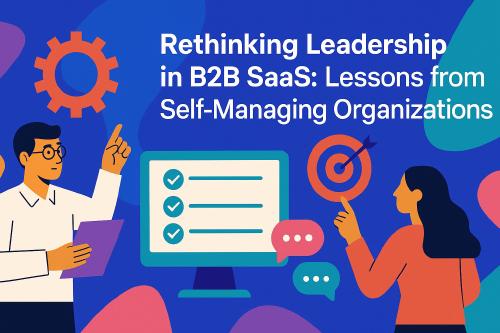Selling DevEx Initiatives in Purpose vs. Profit-oriented Companies
For years, a conversation has been ongoing on naming in the DevEx community (and within myself). Of course. Naming is hard, and why shouldn’t it be any different for this domain?
This post isn’t about naming. It is about organizational priorities and how our understanding of those as technical leaders influences how we communicate. Organizational priorities define how we can sell DevEx initiatives to the business.
“Developer Experience” was always the term feeling right (for me). I also considered “Developer Productivity” and “Developer Effectiveness”. Those terms all mean slightly different things. However, they are often used synonymously, which is not surprising. They are highly interconnected and influence each other. They are not different dimensions but rather flavors of the same thing. I wrote about naming and why I favor Developer Experience a while ago.
In this article, I approach this topic from the perspective of priorities. In the above article from February 2022, I wrote, “Business wants developer effectiveness”. I believe this is true for most but not all businesses.
Things started to click when I read about the developmental stages of organizations in “Reinventing Organizations” by Frederic Laloux (highly recommended read).
Organizational Development Stages
The author describes five stages of organizations linked to human consciousness. While no stage is necessarily better or worse than another, some are better suited for certain contexts than others. Many problems in organizations come from trying to run companies like in 1985.
In short, the five stages are:
- Impulsive Red:
- Emerged as small conquering troops led by an “alpha wolf” who exercises power through fear and strength.
- Lack formal hierarchies or titles and are not scalable in the long run.
- Better suited for chaotic environments but struggle with complex problems.
- Examples include mafias and street gangs.
- Conformist Amber:
- Transition from tribal to agricultural societies, establishing states, civilizations, and bureaucracies.
- Introduced long-term planning and stable organizational structures.
- Authority is role-based, with fixed titles and hierarchies.
- Examples include traditional religious institutions like the Catholic Church.
- Achievement Orange:
- Emerged during the Industrial Revolution, focusing on innovation, responsibility, meritocracy, and profit.
- Encourages multidisciplinary teams and interdepartmental collaboration for increased innovation.
- Management evolved to utilize collective intelligence, shifting towards management by objectives.
- Pluralistic Green:
- Opposes hierarchy and power abuse, valuing equality, cooperation, harmony, and consensus.
- Introduced empowerment, value-oriented culture, and multiple stakeholder perspectives.
- Decisions are made by consensus, with a move towards servant and egalitarian leadership.
- Evolutionary Teal:
- Understands organizations as living organisms with their own evolutionary purposes.
- Embraces self-management and operating without hierarchical structures.
- Engages everyone in listening to the organization’s emergent direction, leveraging peer relationships for decision-making and conflict resolution.
Today, most for-profit organizations are in the Orange stage, while some non-profit organizations tend toward the Green stage. This is not a black/white separation. Organizations can be in Green or Teal in one part while fundamentally being in Orange. The question is, what is the organizational priority? What will be the focus when shit hits the fan?
What is the organizational priority?
Many organizations have values nowadays. Mission and purpose statements are shared on company web pages and in company handbooks. If those proclamations match reality, that transparency is a good thing. It is also easy to follow a purpose, such as protecting the environment or healing humans, as long as profits flow in and no tough decisions need to be made.
When a (temporary) conflict between profit and purpose arises, priorities become clear. Here, we can distinguish organizations operating from Teal and organizations operating from a non-teal mindset.
What has all this to do with Developer Experience?
The Link to DevEx
Think of a DevEx initiative you would like to start because you believe your engineering team can work better and more joyfully. What do you need to do for this initiative to become a reality? Let’s assume that the initiative costs significant time and money.
In organizations operating from Orange, you would probably make a business case for how much money the initiative will save or bring the company vs. how much it will cost. You will convince leaders and leaders of leaders that this is a worthy investment based on profit. Of course, you will make up some numbers and guess the rest. No problem. Trying to predict the future aligns with how Orange organizations work. Showing the monetary benefits of an initiative is what gets it accepted in Orange.
In Green, you suggest the initiative to leadership and affected employees. You might try to link it to the company values. The initiative will happen if you can convince everybody and a consensus is made. Convincing people that the initiative is good and aligned with company values gets it accepted in Green.
In organizations in the Teal stage, things look different. First, the fundamental assumption here differs: People do their best to further the organizational purpose. The fact that you propose an initiative is enough to assume it supports the purpose. You will invest time to help people understand how it aligns with the purpose. People trust you, and you trust the people. People have a higher role in Teal organizations, and the organization deeply cares for the people.
In other words, in Teal, you do not need to convince anybody how much more productive, engaged, or motivated people will be or how much cost the company will save due to lower churn if they have a less frustrating work experience. That is irrelevant. Creating a better workplace where people feel valued and enabled to do their best work is enough reason. The initiative will be accepted unless somebody objects by explaining how the initiative would harm the organization in Teal organizations.
The Tragedy of Orange
Burnout, frustration, disengagement, conflicts, and disconnect are rising in many organizations today. Looking into those problems, it is striking that they come from Orange thinking: Career ladders, hierarchies, achievements, carrots and sticks, profits first.
Orange companies want higher profits. Their design prevents it. People cannot be at their best in organizations in Orange. People waste time, energy, and creativity on proving their idea is worthy, how it will increase profit, and why they are better than others. While everybody is focused on profit and status, opportunities are missed, and energy is wasted.
Instead of evolving into a more beautiful organism that values humans and focuses on a positive impact on the world, those companies are stuck in chasing profit, regularly missing opportunities for much higher success.
Short: By focusing on profits, companies in Orange miss the bigger picture, miss opportunities, and, in the end, miss profits. They cause misery that could be prevented.
Summary
The role of DevEx depends on the developmental stage of an organization. In Orange, DevEx is a means to an end, and that end is profit. In Green, aligning with values and the group’s perception is likely more important. Finally, Teal is about humans, human needs, and purpose. Profit isn’t the goal but a side-effect of doing the right thing.
Your context as a leader (someone driving an initiative) defines how you must communicate to be heard.
Chances are that your nature and thinking have evolved beyond Orange thinking while operating in an Orange-dominated organization. That is an opportunity. By understanding the organizational stage, you can find the right arguments for initiatives that improve and change the organization from within.
- When selling DevEx initiatives in companies in Orange, link them to money and make a compelling business case.
- When suggesting DevEx initiatives in companies in Green, link them to values and hope for consensus.
- When driving DevEx initiatives in companies in Teal, link them to purpose and default to yes.
How do DevEx initiatives get time and money in your organization?





Use the share button below if you liked it.
It makes me smile, when I see it.